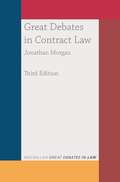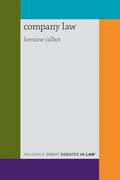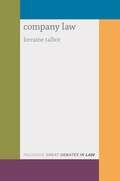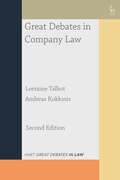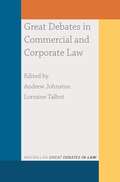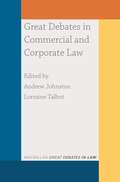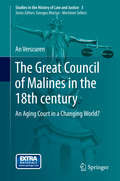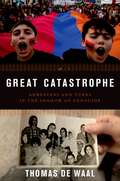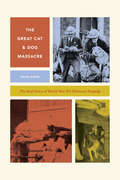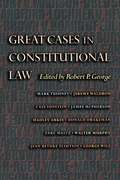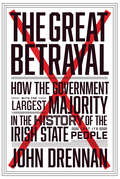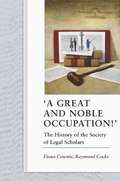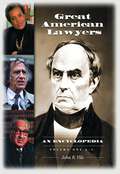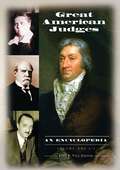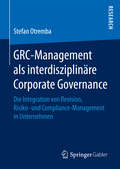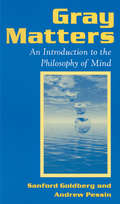- Table View
- List View
Great Debates in Contract Law (Great Debates in Law)
by Jonathan MorganThis textbook is an engaging introduction to the more advanced writings on contract law, primarily designed to allow students to 'get under the skin' of the topic and begin to build their critical thinking and analysis skills. Each chapter is structured around key questions and debates that provoke deeper thought and, ultimately, a clearer understanding. This edition has been extensively rewritten to include new cases and scholarship throughout. New sections include 'no oral modification' clauses, substantive fairness, regulation of standard-form contracts, and remoteness of damage in contract.An excellent book for students of contract law who wish to know more, the aim of the book is not to present a complete overview of theoretical issues in contract law, but rather to illustrate the current debates which are currently going on among those working in shaping the area. The text features summaries of the views of notable experts on key topics and each chapter ends with a list of guided further reading. New to this Edition:- Extensively rewritten to include new cases and scholarship throughout.- New sections and debates include 'no oral modification' clauses, substantive fairness, regulation of standard-form contracts, and remoteness of damage in contract.
Great Debates in Company Law (PDF)
by Lorraine TalbotAn engaging introduction to some of the more advanced concepts in Company Law and corporate governance, providing a cutting edge for students who are looking to gain additional insights with which to excel. Readers are introduced to the many debates surrounding each core area and presented with the key tensions and questions underlying each topic.
Great Debates in Company Law (Great Debates in Law)
by Lorraine TalbotThis textbook is an ambitious and engaging introduction to the more advanced writings on company law, primarily designed to allow students to ‘get under the skin’ of the topic and begin to build their critical thinking and analysis skills. Each chapter is structured around key questions and debates that provoke deeper thought and, ultimately, a clearer understanding. The aim of the book is therefore not to present a complete overview of theoretical issues in company law, but rather to illustrate the current debates which are currently going on among those working in shaping the area. The text features summaries of the views of notable experts on key topics and each chapter ends with a list of guided further reading.
Great Debates in Company Law (Great Debates in Law)
by Lorraine Talbot Dr Andreas KokkinisA thoroughly updated new edition of this successful and influential text, it helps students gain a critical understanding of the key debates shaping the field of company law.The new edition has been updated to include many substantial developments in company law, specifically the area of board diversity, corporate social responsibility, shareholder control, director remuneration and human rights.
Great Debates in Company Law (Great Debates in Law)
by Lorraine Talbot Dr Andreas KokkinisA thoroughly updated new edition of this successful and influential text, it helps students gain a critical understanding of the key debates shaping the field of company law.The new edition has been updated to include many substantial developments in company law, specifically the area of board diversity, corporate social responsibility, shareholder control, director remuneration and human rights.
Great Debates in Commercial and Corporate Law (Great Debates in Law)
by Jonathan Morgan Peter Harrison Kerrie Sadiq Robert Burrell Catherine Mitchell Charlotte Villiers Roseanne Russell Emily Hudson Daniel Attenborough Bronwyn McCredie Jay CullenAn exciting new textbook which presents critical perspectives on corporate and commercial law. Focussing on the key areas of trade and transactions, intellectual property, corporations and finance, it covers each of the areas of commercial and company law that would typically be offered to undergraduate and postgraduate law students. The chapters are written by acknowledged experts in the field and are aimed at undergraduates, post graduates and lecturers who wish to further their understanding of this area. Each of the authors focuses on an area within their subject and draws out the political, the controversial and the discursive, providing essential reading for undergraduate dissertation topics and postgraduate analysis.
Great Debates in Commercial and Corporate Law (Great Debates in Law)
by Jonathan Morgan Catherine Mitchell Charlotte Villiers Roseanne Russell Peter Harrison Robert Burrell Emily Hudson Daniel Attenborough Kerrie Sadiq Bronwyn McCredie Jay CullenAn exciting new textbook which presents critical perspectives on corporate and commercial law. Focussing on the key areas of trade and transactions, intellectual property, corporations and finance, it covers each of the areas of commercial and company law that would typically be offered to undergraduate and postgraduate law students. The chapters are written by acknowledged experts in the field and are aimed at undergraduates, post graduates and lecturers who wish to further their understanding of this area. Each of the authors focuses on an area within their subject and draws out the political, the controversial and the discursive, providing essential reading for undergraduate dissertation topics and postgraduate analysis.
The Great Council of Malines in the 18th century: An Aging Court in a Changing World? (Studies in the History of Law and Justice #3)
by An VerscurenThis work studies the Great Council of Malines as an institution. It analyzes the Council’s internal organization and staff policy, its position within the broader society of the Austrian Netherlands, the volume and nature of litigation at the Council and its final years and ultimate demise in the late 18th and early 19th century. By means of this institutional study, this volume provides insight into the role played by the Great Council in the process of state-building in the 18th century Austrian Netherlands. While superior courts were once considered to be the prime agencies of change in the Early Modern Period, tools par excellence for the sovereigns’ striving towards centralization and superiority, their position in the 18th century has so far been barely touched upon. This work focuses specifically on the 18th century supreme court of the Austrian Netherlands and provides a broad overview with attention to other aspects of the tribunal's functioning and to its role in 18th century attempts at state formation.
Great Catastrophe: Armenians and Turks in the Shadow of Genocide
by Thomas de WaalThe destruction of the Armenians of the Ottoman Empire in 1915-16 was the greatest atrocity of World War I. Around one million Armenians were killed, and the survivors were scattered across the world. Although it is now a century old, the issue of what most of the world calls the Armenian Genocide of 1915 is still a live and divisive issue that mobilizes Armenians across the world, shapes the identity and politics of modern Turkey, and has consumed the attention of U.S. politicians for years. In Great Catastrophe, the eminent scholar and reporter Thomas de Waal looks at the aftermath and politics of the Armenian Genocide and tells the story of recent efforts by courageous Armenians, Kurds, and Turks to come to terms with the disaster as Turkey enters a new post-Kemalist era. The story of what happened to the Armenians in 1915-16 is well-known. Here we are told the "history of the history" and the lesser-known story of what happened to Armenians, Kurds, and Turks in the century that followed. De Waal relates how different generations tackled the issue of the "Great Catastrophe" from the 1920s until the failure of the Protocols signed by independent Armenia and Turkey in 2010. Quarrels between diaspora Armenians supporting and opposing the Soviet Union broke into violence and culminated with the murder of an archbishop in 1933. The devising of the word "genocide," the growth of modern identity politics, and the 50th anniversary of the massacres re-energized a new generation of Armenians. In Turkey the issue was initially forgotten, only to return to the political agenda in the context of the Cold War and an outbreak of Armenian terrorism. More recently, Turkey has started to confront its taboos. In an astonishing revival of oral history, the descendants of tens of thousands of "Islamized Armenians," who have been in the shadows since 1915, have begun to reemerge and reclaim their identities. Drawing on archival sources, reportage and moving personal stories, de Waal tells the full story of Armenian-Turkish relations since the Genocide in all its extraordinary twists and turns. He looks behind the propaganda to examine the realities of a terrible historical crime and the divisive "politics of genocide" it produced. The book throws light not only on our understanding of Armenian-Turkish relations but also of how mass atrocities and historical tragedies shape contemporary politics.
Great Catastrophe: Armenians and Turks in the Shadow of Genocide
by Thomas de WaalThe destruction of the Armenians of the Ottoman Empire in 1915-16 was the greatest atrocity of World War I. Around one million Armenians were killed, and the survivors were scattered across the world. Although it is now a century old, the issue of what most of the world calls the Armenian Genocide of 1915 is still a live and divisive issue that mobilizes Armenians across the world, shapes the identity and politics of modern Turkey, and has consumed the attention of U.S. politicians for years. In Great Catastrophe, the eminent scholar and reporter Thomas de Waal looks at the aftermath and politics of the Armenian Genocide and tells the story of recent efforts by courageous Armenians, Kurds, and Turks to come to terms with the disaster as Turkey enters a new post-Kemalist era. The story of what happened to the Armenians in 1915-16 is well-known. Here we are told the "history of the history" and the lesser-known story of what happened to Armenians, Kurds, and Turks in the century that followed. De Waal relates how different generations tackled the issue of the "Great Catastrophe" from the 1920s until the failure of the Protocols signed by independent Armenia and Turkey in 2010. Quarrels between diaspora Armenians supporting and opposing the Soviet Union broke into violence and culminated with the murder of an archbishop in 1933. The devising of the word "genocide," the growth of modern identity politics, and the 50th anniversary of the massacres re-energized a new generation of Armenians. In Turkey the issue was initially forgotten, only to return to the political agenda in the context of the Cold War and an outbreak of Armenian terrorism. More recently, Turkey has started to confront its taboos. In an astonishing revival of oral history, the descendants of tens of thousands of "Islamized Armenians," who have been in the shadows since 1915, have begun to reemerge and reclaim their identities. Drawing on archival sources, reportage and moving personal stories, de Waal tells the full story of Armenian-Turkish relations since the Genocide in all its extraordinary twists and turns. He looks behind the propaganda to examine the realities of a terrible historical crime and the divisive "politics of genocide" it produced. The book throws light not only on our understanding of Armenian-Turkish relations but also of how mass atrocities and historical tragedies shape contemporary politics.
The Great Cat and Dog Massacre: The Real Story of World War Two's Unknown Tragedy (Animal Lives)
by Hilda KeanThe tragedies of World War II are well known. But at least one has been forgotten: in September 1939, four hundred thousand cats and dogs were massacred in Britain. The government, vets, and animal charities all advised against this killing. So why would thousands of British citizens line up to voluntarily euthanize household pets? In The Great Cat and Dog Massacre, Hilda Kean unearths the history, piecing together the compelling story of the life—and death—of Britain’s wartime animal companions. She explains that fear of imminent Nazi bombing and the desire to do something to prepare for war led Britons to sew blackout curtains, dig up flower beds for vegetable patches, send their children away to the countryside—and kill the family pet, in theory sparing them the suffering of a bombing raid. Kean’s narrative is gripping, unfolding through stories of shared experiences of bombing, food restrictions, sheltering, and mutual support. Soon pets became key to the war effort, providing emotional assistance and helping people to survive—a contribution for which the animals gained government recognition. Drawing extensively on new research from animal charities, state archives, diaries, and family stories, Kean does more than tell a virtually forgotten story. She complicates our understanding of World War II as a “good war” fought by a nation of “good” people. Accessibly written and generously illustrated, Kean’s account of this forgotten aspect of British history moves animals to center stage—forcing us to rethink our assumptions about ourselves and the animals with whom we share our homes.
The Great Cat and Dog Massacre: The Real Story of World War Two's Unknown Tragedy (Animal Lives)
by Hilda KeanThe tragedies of World War II are well known. But at least one has been forgotten: in September 1939, four hundred thousand cats and dogs were massacred in Britain. The government, vets, and animal charities all advised against this killing. So why would thousands of British citizens line up to voluntarily euthanize household pets? In The Great Cat and Dog Massacre, Hilda Kean unearths the history, piecing together the compelling story of the life—and death—of Britain’s wartime animal companions. She explains that fear of imminent Nazi bombing and the desire to do something to prepare for war led Britons to sew blackout curtains, dig up flower beds for vegetable patches, send their children away to the countryside—and kill the family pet, in theory sparing them the suffering of a bombing raid. Kean’s narrative is gripping, unfolding through stories of shared experiences of bombing, food restrictions, sheltering, and mutual support. Soon pets became key to the war effort, providing emotional assistance and helping people to survive—a contribution for which the animals gained government recognition. Drawing extensively on new research from animal charities, state archives, diaries, and family stories, Kean does more than tell a virtually forgotten story. She complicates our understanding of World War II as a “good war” fought by a nation of “good” people. Accessibly written and generously illustrated, Kean’s account of this forgotten aspect of British history moves animals to center stage—forcing us to rethink our assumptions about ourselves and the animals with whom we share our homes.
The Great Cat and Dog Massacre: The Real Story of World War Two's Unknown Tragedy (Animal Lives)
by Hilda KeanThe tragedies of World War II are well known. But at least one has been forgotten: in September 1939, four hundred thousand cats and dogs were massacred in Britain. The government, vets, and animal charities all advised against this killing. So why would thousands of British citizens line up to voluntarily euthanize household pets? In The Great Cat and Dog Massacre, Hilda Kean unearths the history, piecing together the compelling story of the life—and death—of Britain’s wartime animal companions. She explains that fear of imminent Nazi bombing and the desire to do something to prepare for war led Britons to sew blackout curtains, dig up flower beds for vegetable patches, send their children away to the countryside—and kill the family pet, in theory sparing them the suffering of a bombing raid. Kean’s narrative is gripping, unfolding through stories of shared experiences of bombing, food restrictions, sheltering, and mutual support. Soon pets became key to the war effort, providing emotional assistance and helping people to survive—a contribution for which the animals gained government recognition. Drawing extensively on new research from animal charities, state archives, diaries, and family stories, Kean does more than tell a virtually forgotten story. She complicates our understanding of World War II as a “good war” fought by a nation of “good” people. Accessibly written and generously illustrated, Kean’s account of this forgotten aspect of British history moves animals to center stage—forcing us to rethink our assumptions about ourselves and the animals with whom we share our homes.
The Great Cat and Dog Massacre: The Real Story of World War Two's Unknown Tragedy (Animal Lives)
by Hilda KeanThe tragedies of World War II are well known. But at least one has been forgotten: in September 1939, four hundred thousand cats and dogs were massacred in Britain. The government, vets, and animal charities all advised against this killing. So why would thousands of British citizens line up to voluntarily euthanize household pets? In The Great Cat and Dog Massacre, Hilda Kean unearths the history, piecing together the compelling story of the life—and death—of Britain’s wartime animal companions. She explains that fear of imminent Nazi bombing and the desire to do something to prepare for war led Britons to sew blackout curtains, dig up flower beds for vegetable patches, send their children away to the countryside—and kill the family pet, in theory sparing them the suffering of a bombing raid. Kean’s narrative is gripping, unfolding through stories of shared experiences of bombing, food restrictions, sheltering, and mutual support. Soon pets became key to the war effort, providing emotional assistance and helping people to survive—a contribution for which the animals gained government recognition. Drawing extensively on new research from animal charities, state archives, diaries, and family stories, Kean does more than tell a virtually forgotten story. She complicates our understanding of World War II as a “good war” fought by a nation of “good” people. Accessibly written and generously illustrated, Kean’s account of this forgotten aspect of British history moves animals to center stage—forcing us to rethink our assumptions about ourselves and the animals with whom we share our homes.
The Great Cat and Dog Massacre: The Real Story of World War Two's Unknown Tragedy (Animal Lives)
by Hilda KeanThe tragedies of World War II are well known. But at least one has been forgotten: in September 1939, four hundred thousand cats and dogs were massacred in Britain. The government, vets, and animal charities all advised against this killing. So why would thousands of British citizens line up to voluntarily euthanize household pets? In The Great Cat and Dog Massacre, Hilda Kean unearths the history, piecing together the compelling story of the life—and death—of Britain’s wartime animal companions. She explains that fear of imminent Nazi bombing and the desire to do something to prepare for war led Britons to sew blackout curtains, dig up flower beds for vegetable patches, send their children away to the countryside—and kill the family pet, in theory sparing them the suffering of a bombing raid. Kean’s narrative is gripping, unfolding through stories of shared experiences of bombing, food restrictions, sheltering, and mutual support. Soon pets became key to the war effort, providing emotional assistance and helping people to survive—a contribution for which the animals gained government recognition. Drawing extensively on new research from animal charities, state archives, diaries, and family stories, Kean does more than tell a virtually forgotten story. She complicates our understanding of World War II as a “good war” fought by a nation of “good” people. Accessibly written and generously illustrated, Kean’s account of this forgotten aspect of British history moves animals to center stage—forcing us to rethink our assumptions about ourselves and the animals with whom we share our homes.
The Great Cat and Dog Massacre: The Real Story of World War Two's Unknown Tragedy (Animal Lives)
by Hilda KeanThe tragedies of World War II are well known. But at least one has been forgotten: in September 1939, four hundred thousand cats and dogs were massacred in Britain. The government, vets, and animal charities all advised against this killing. So why would thousands of British citizens line up to voluntarily euthanize household pets? In The Great Cat and Dog Massacre, Hilda Kean unearths the history, piecing together the compelling story of the life—and death—of Britain’s wartime animal companions. She explains that fear of imminent Nazi bombing and the desire to do something to prepare for war led Britons to sew blackout curtains, dig up flower beds for vegetable patches, send their children away to the countryside—and kill the family pet, in theory sparing them the suffering of a bombing raid. Kean’s narrative is gripping, unfolding through stories of shared experiences of bombing, food restrictions, sheltering, and mutual support. Soon pets became key to the war effort, providing emotional assistance and helping people to survive—a contribution for which the animals gained government recognition. Drawing extensively on new research from animal charities, state archives, diaries, and family stories, Kean does more than tell a virtually forgotten story. She complicates our understanding of World War II as a “good war” fought by a nation of “good” people. Accessibly written and generously illustrated, Kean’s account of this forgotten aspect of British history moves animals to center stage—forcing us to rethink our assumptions about ourselves and the animals with whom we share our homes.
Great Cases in Constitutional Law
by Robert P. GeorgeSlavery, segregation, abortion, workers' rights, the power of the courts. These issues have been at the heart of the greatest constitutional controversies in American history. And in this concise and thought-provoking volume, some of today's most distinguished legal scholars and commentators explain for a general audience how five landmark Supreme Court cases centered on those controversies shaped the country's destiny and continue to affect us even now. The book is a profound exploration of the Supreme Court's importance to America's social and political life. It is also, as many of the contributors show, an intriguing reflection of what some have seen as an important trend in legal scholarship away from an uncritical belief in the essentially benign nature of judicial power. Robert George opens with an illuminating survey of the themes that unite and divide the five cases. Other contributors then examine each case in detail through a lively commentary-and-response format. Mark Tushnet and Jeremy Waldron exchange views on Marbury v. Madison, the pivotal 1803 case that established the power of the courts to invalidate legislation. Cass Sunstein and James McPherson discuss Dred Scott v. Sandford (1857), the notorious case that confirmed the rights of slaveowners, declared that black people could not be American citizens, and is often seen as a cause of the Civil War. Hadley Arkes and Donald Drakeman explore the legacy of Lochner v. New York (1905), a case that ushered in decades of judicial hostility to social welfare laws. Earl Maltz and Walter Murphy assess Brown v. Topeka Board of Education (1954), the famous case that ended racial segregation in public schools. Finally, Jean Bethke Elshtain and George Will tackle Roe v. Wade (1973), still a flashpoint a quarter of a century later in the debate over abortion. While some of the contributors show sympathy for strong judicial interventions on social issues, many across the ideological spectrum are sharply critical of judicial activism. A compelling introduction to the greatest cases in U.S. constitutional law, this is also an enlightening glimpse of the state of the art in American legal scholarship.
Great Cases in Constitutional Law
by Robert P. GeorgeSlavery, segregation, abortion, workers' rights, the power of the courts. These issues have been at the heart of the greatest constitutional controversies in American history. And in this concise and thought-provoking volume, some of today's most distinguished legal scholars and commentators explain for a general audience how five landmark Supreme Court cases centered on those controversies shaped the country's destiny and continue to affect us even now. The book is a profound exploration of the Supreme Court's importance to America's social and political life. It is also, as many of the contributors show, an intriguing reflection of what some have seen as an important trend in legal scholarship away from an uncritical belief in the essentially benign nature of judicial power. Robert George opens with an illuminating survey of the themes that unite and divide the five cases. Other contributors then examine each case in detail through a lively commentary-and-response format. Mark Tushnet and Jeremy Waldron exchange views on Marbury v. Madison, the pivotal 1803 case that established the power of the courts to invalidate legislation. Cass Sunstein and James McPherson discuss Dred Scott v. Sandford (1857), the notorious case that confirmed the rights of slaveowners, declared that black people could not be American citizens, and is often seen as a cause of the Civil War. Hadley Arkes and Donald Drakeman explore the legacy of Lochner v. New York (1905), a case that ushered in decades of judicial hostility to social welfare laws. Earl Maltz and Walter Murphy assess Brown v. Topeka Board of Education (1954), the famous case that ended racial segregation in public schools. Finally, Jean Bethke Elshtain and George Will tackle Roe v. Wade (1973), still a flashpoint a quarter of a century later in the debate over abortion. While some of the contributors show sympathy for strong judicial interventions on social issues, many across the ideological spectrum are sharply critical of judicial activism. A compelling introduction to the greatest cases in U.S. constitutional law, this is also an enlightening glimpse of the state of the art in American legal scholarship.
The Great Betrayal: How the Government with the Largest Majority in the History of the Irish State Lost its People
by John DrennanFrom penalty points to water charges, funding cuts to tax hikes, The Great Betrayal is a cutting assessment of the upheavals, egos and scraps that shaped the 31st Dáil by Ireland’s most sagacious political pundit-turned-political operatorAs the curtain falls on this government’s term in office, it has fallen drastically out of favour, something that is hard to believe if we cast our minds back just a few years to 2011, when Fine Gael and Labour rode a wave of populist sentiment all the way to Dáil Eireann. No Irish government has ever enjoyed a larger majority – and none has ever so comprehensively squandered its mandate. How did the Coalition fall so far so fast?Written with the unique insight of one of the most original observers of Irish politics, The Great Betrayal provides an entertaining and enlightening narrative of a government that, in the eyes of many, betrayed the hopes of the Irish electorate for a democratic revolution, almost immediately after being elected with a thumping majority.The Great Betrayal is required reading for anyone wondering how it all went wrong and where we might go from here.
'A Great and Noble Occupation!': The History of the Society of Legal Scholars
by Fiona Cownie Raymond CocksThe Society of Legal Scholars, originally the Society of Public Teachers of Law, was created in 1909, but was fortunate to survive its first half century. It had few members, lacked financial resources and was weak in influence. In comparison with other university disciplines Law enjoyed a fragile status, and was often held in low esteem by barristers and solicitors. At times the SPTL was caught up in problems of its own making, for instance refusing to admit women until the late 1940s. But there were also moments of excitement and achievement: the years between 1909 and the start of WWI were full of hope and new ideas and the establishment of the Journal of the Society of Public Teachers of Law in the 1920s was an important achievement for legal scholars. During the social revolution of the 1960s the SPTL continued to function as a rather sedate gentleman's club, gathering at its annual conference to socialise, rather than to engage in academic debate. The 1970s saw a sustained drive from its Young Members' Group to create a new, more serious organisation, with better conferences and more effective decision-making processes. The Society evolved slowly, but the process accelerated in the 1990s, with members encouraged to reinforce their intellectual contribution to the discipline and act as a central point for policy debate within the legal academic community. As we stand at the beginning of the twenty first century, the Society, with nearly 3,000 members, has come a long way from its small beginnings.
Great American Lawyers [2 volumes]: An Encyclopedia [2 volumes]
by John R. VileThis two volume set offers unmatched insight into the lives and careers of 100 of America's most notable defense and prosecuting attorneys.Trial lawyers, noted one observer, are "the closest thing America has to the Knights of the Round Table." In this new two volume encyclopedia, which chronicles the lives and careers of America's 100 greatest trial lawyers, readers can explore the historic legal careers of extraordinary barristers like Thomas Jefferson, the young Virginia attorney who drafted the Declaration of Independence, and Daniel Webster, staunch defender of the union.Readers will also meet contemporary litigators like Lawrence Tribe, who led the fight against the tobacco industry; Marian Wright Edelman, a leading advocate for children's rights; Alan Dershowitz, renowned criminal appellate lawyer and public intellectual; and Johnnie Cochran, the defense attorney whose spectacular victory in the O. J. Simpson trial propelled him to superstardom. In the stories of these preeminent litigators, readers will discover not only what qualities make a great lawyer, but also how much we owe to those who have served as our legal advocates.
Great American Judges [2 volumes]: An Encyclopedia [2 volumes]
by John R. VileInspiring and instructive biographies of the 100 most influential judges from state and federal courts in one easy-to-access volume.Great American Judges profiles 100 outstanding judges and justices in a full sweep of U.S. history. Chosen by lawyers, historians, and political scientists, these men and women laid the foundation of U.S. law. A complement to Great American Lawyers, together these two volumes create a complete picture of our nation's top legal minds from colonial times to today.Following an introduction on the role of judges in American history are A–Z biographical entries portraying this diverse group from extraordinarily different backgrounds. Students and history enthusiasts will appreciate the accomplishments of these role models and the connections between their inspiring lives and their far-reaching legal decisions. William Rehnquist, Oliver Wendell Holmes, Jr., and 12 other Supreme Court justices are found alongside federal judges like Skelly Wright, who ordered school desegregation in 1960. Influential state judges such as Rose Elizabeth Bird, California's first woman Supreme Court Chief Justice, are also featured.
GRC-Management als interdisziplinäre Corporate Governance: Die Integration von Revision, Risiko- und Compliance-Management in Unternehmen
by Stefan OtrembaStefan Otremba beantwortet die Frage, wie Unternehmen den gestiegenen rechtlichen und gesellschaftlichen Anforderungen gerecht werden können, ohne dabei an Effizienz und Agilität zu verlieren. Die Lösung liegt in der integrativen Betrachtung von Governance (G), Risikomanagement (R) und Compliance (C). Im Zentrum steht das vom Autor entwickelte GRC-Gesamtkonzept zur wirksamen Vermeidung von finanziellen, rechtlichen und Reputationsrisiken. Das vorliegende Buch gibt einen Einblick in die Mechanismen der Corporate Governance, entwickelt diese vor dem Hintergrund ethischer sowie organisationaler Aspekte weiter und weist damit den Weg in Richtung einer verantwortungsvollen Unternehmensführung in Zeiten der Globalisierung.
Gray Matters: Introduction to the Philosophy of Mind
by Andrew Pessin Sanford GoldbergGray Matters is a thorough examination of the main topics in recent philosophy of mind. It aims at surveying a broad range of issues, not all of which can be subsumed under one position or one philosopher's theory. In this way, the authors avoid neglecting interesting issues out of allegiance to a given theory of mind.
Gray Matters: Introduction to the Philosophy of Mind
by Andrew Pessin Sanford GoldbergGray Matters is a thorough examination of the main topics in recent philosophy of mind. It aims at surveying a broad range of issues, not all of which can be subsumed under one position or one philosopher's theory. In this way, the authors avoid neglecting interesting issues out of allegiance to a given theory of mind.
